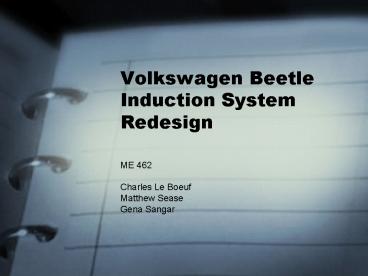Volkswagen Beetle Induction System Redesign - PowerPoint PPT Presentation
1 / 29
Title: Volkswagen Beetle Induction System Redesign
1
Volkswagen Beetle Induction System Redesign
- ME 462
- Charles Le Boeuf
- Matthew Sease
- Gena Sangar
2
Team Members and Roles
- ME Members
- Gena Sangar
- Matthew Sease
- Charles Le Boeuf
- Roles
- Product Manager (ECE Liaison)
- Product Design Engineer
- Manufacturing Engineer
- Detailer
- Drafter
3
Project Description
- To upgrade the VW Beetle (circa 1932 to 1975)
carbureted induction system to a modern EFI
system.
Old System New System
- This includes
- Redesign of the air intake system.
- Redesign of the fuel delivery system.
4
Market Analysis
- Carburetors are obsolete
- EFI attractive upgrade
- Beetles were Mass produced
- Use in vintage restoration and auto racing arenas
- Large potential market
5
Design Objective
- To increase the volumetric efficiency of the
engine. - To improve horsepower.
- To improve torque.
- To improve fuel economy.
6
Executive Summary
- Improvement Identified
- Current VW air and fuel delivery system
- Objective
- Innovative redesign
- Market research
- Methods
- Analytical research
- Numerical analysis
- Prototype design
- Manufacture
- Implementation
- Observation
- Results
- 13 of 14 engineering requirements were met or
exceeded. - 4 out of 18 were not able to be tested at this
time, are anticipated to meet criteria well. - With finished testing and revision, product will
be ready for market.
7
Analysis Approach
- Identify critical design criteria
- Identify Analytical Methods
- Identify FEA Simulation Methods
8
Analysis and Modeling
- Analytical Methods
- Dynamic air system equations
- Mixture optimization (Stoichiometric combustion
equations) - Geometric optimization
- Simulation Methods
- COSMOS
- AFT Fathom
9
Analysis and Modeling Cont.
- COSMOS FEA
10
Analysis and Modeling Cont.
- COSMOS FEA
11
Analysis and Modeling Cont.
- CAD Fuel System Layout
12
Analysis and Modeling Cont.
- AFT Fathom
13
Analysis and Modeling Cont.
- AFT Fathom
14
Analysis and Modeling Cont.
- AFT Fathom
15
Final Design
- Structural F.O.S. of 356
- Thermal F.O.S. of 2.5
- Tuned port geometry optimized at 4000 RPM (22
length, 1.3 diam.) - Fuel system specified (19 lb/hr at 45 PSI)
- Critical packaging parameters achieved
16
Final Design
Fuel Pressure Gauge
Adjustable Fuel Pressure Regulator
Upper Runners
Fuel Rail
Down Tube
Throttle Body
Lower Runner
17
Prototype Manufacturing
- Carbon Fiber Components Created
18
Manufacturing Process
19
Manufacturing Process
20
Manufacturing Process
21
Prototype Manufacturing
- Aluminum components machined
22
Prototype Manufacturing
- Finished prototype components
23
Prototype Manufacturing
- Test fit and Troubleshooting
24
Prototype Manufacturing
- Component Specifications
- All sensors and components specified were OEM
General Motors or equivalent (Delco/Delphi) - Off-shelf availability
- Recyclability
- Maintenance friendly
25
Areas of Improvement
- Revision B
- All braided stainless fuel lines
- In-line fuel pump
- Socket relief in injector block
- Fuel rail redesign to incorporate OEM retaining
clips - Move location of adjustable fuel pressure
regulator - Design steeper injector angle into injector
blocks, incorporate long injector pintle - Original throttle body design
- Tweak upper runner geometry on driver side fan
shroud.
26
Conclusion
- 13 of 14 engineering requirements that were
tested met or exceeded expectations. - 4 out of 18 were not able to be tested at this
time, but are anticipated to meet criteria well. - With finished testing and revision, product will
be ready for market.
27
Recommendations
- Finish the ECU testing and calibration.
- Test mechanical system to completion.
- Bring product to market.
28
Special Thanks to
- Dr. Jie Chen Faculty Sponsor
- Rich Kenny Kenny Brown Performance
- Rick Steinard SPI Racing
- Professor Toksoy IUPUI
- Dave Crawford PDI
- John Kamler Axxis Power Racing
- Ron Kelley IUPUI
- Dr. Pidaparti IUPUI
- Dana Bradbury Machining
- SpA Technique
- North American Race Parts
- Stratasys Inc.
- Mike Kessler ME consultant
- John Spears Speartech
- Ben McCoy ECE consultant
- Arnab Star CD CFD Simulation
- Daniel Reed ECE consultant
29
Discussion































